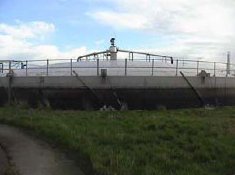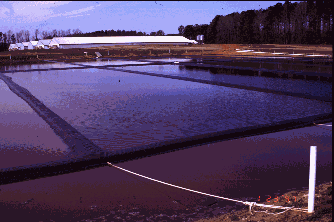anaerobic digester

Figure 1. Anaerobic digester.

Figure 2. Anaerobic lagoon.
An anaerobic digester is a device for optimizing the anaerobic digestion of biomass and/or animal manure and, possibly, for recovering biogas for energy production. Digester types include batch, continuous flow (horizontal or plug-flow, multiple-tank, and vertical tank), complete mix, and covered lagoon.
Factors to consider when designing an anaerobic digestion system include cost, size, local climate, and the availability and type of organic feedstock material.
Anaerobic digesters – also known as biodigesters – are made out of concrete, steel, brick, or plastic. They are shaped like silos, troughs, basins or ponds, and may be placed underground or on the surface. All anaerobic digestion system designs incorporate the same basic components:
Batch digesters
Batch-type digesters are the simplest to build. Their operation consists of loading the digester with organic materials and allowing it to digest. The retention time depends on temperature and other factors. Once the digestion is complete, the effluent is removed and the process is repeated.
Continuous digesters
In a continuous digester, organic material is constantly or regularly fed into the digester. The material moves through the digester either mechanically or by the force of the new feed pushing out digested material. Unlike batch-type digesters, continuous digesters produce biogas without the interruption of loading material and unloading effluent. There are three types of continuous digesters: vertical tank systems, horizontal tank or plug-flow systems, and multiple tank systems.
Proper design, operation, and maintenance of continuous digesters produce a steady and predictable supply of usable biogas. They may be better suited for large-scale operations.
Many livestock operations store the manure they produce in waste lagoons, or ponds. A growing number of these operations are placing floating covers on their lagoons to capture the biogas. They use it to run an engine/generator to produce electricity.
Anaerobic digester system costs vary widely. Systems can be put together using off-the-shelf materials. There are also a few companies that build system components. Some sophisticated systems have been designed by professionals whose major focus is research, not low cost.
Economics and benefits of anaerobic digesters
Before you install a anaerobic digester – also known as a biodigester – on your farm or ranch, you should explore its economic value and potential benefits.
A biodigester usually requires manure from more than 150 large animals to cost effectively generate electricity. Anaerobic digestion and biogas production can also reduce overall operating costs where costs are high for sewage, agricultural, or animal waste disposal, and the effluent has economic value.
